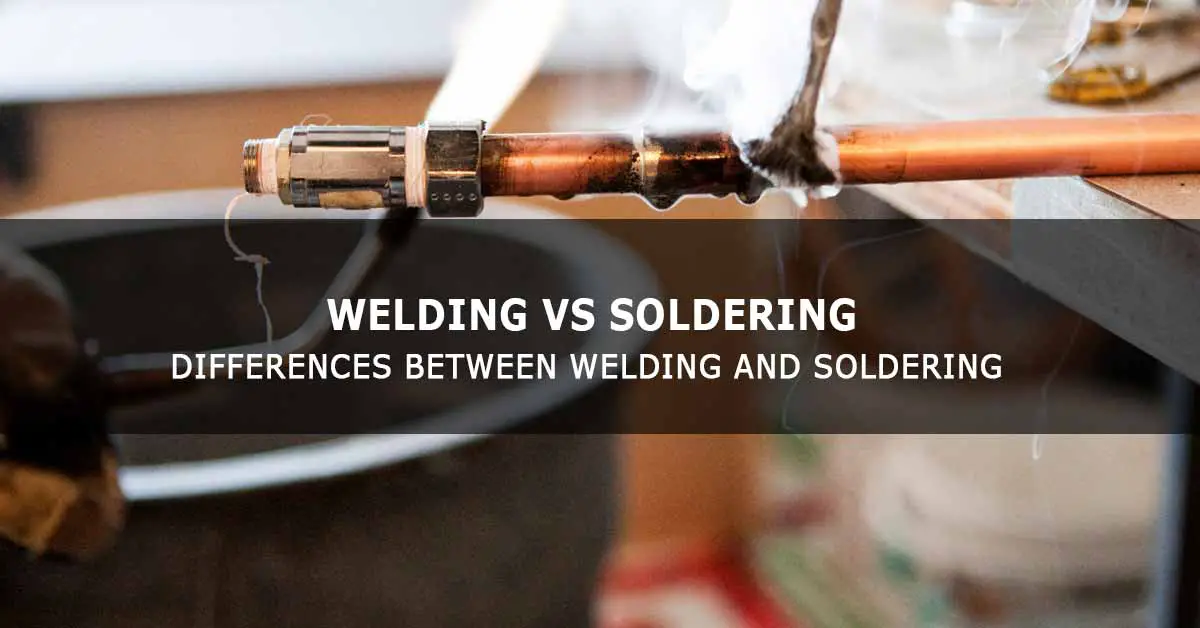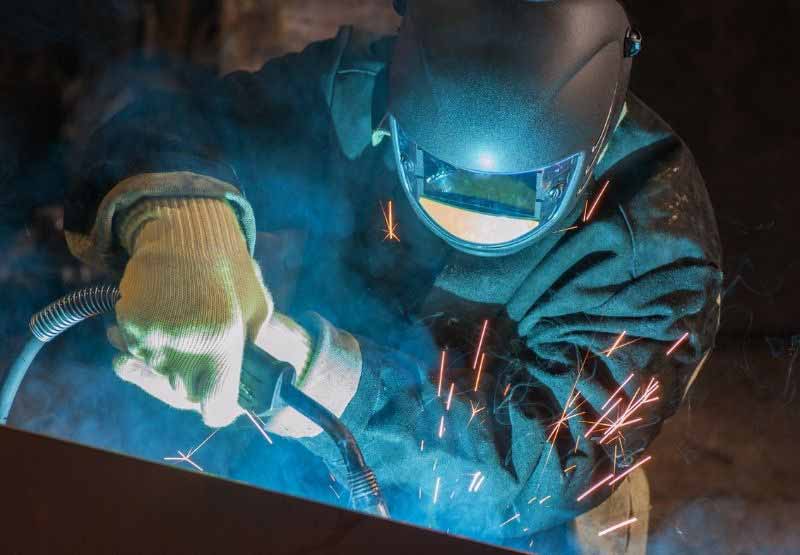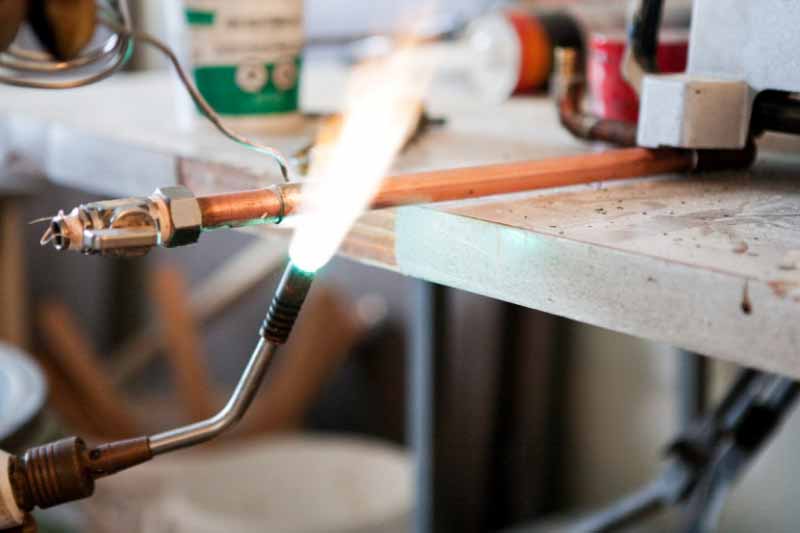Both welding and soldering are techniques used by operators in joining pieces of metal and, in some cases, other types of materials together. Unfortunately, some people use these terms interchangeably, which may confuse a newcomer to the trade. Although these operations are similar, the process of using them, the way to use them, the purpose, and a number of other sub-processes are all different.
To find out more about welding VS soldering – soldering meaning, keep reading on as we explain the main differences between the two processes.
What is Welding?
Welding is the process of joining two or more pieces of metal or other materials together by heating the parts to the degree of melting. The action requires pressing or melting the given parts with or without added material in order to create a firm bond between the two welded parts, also called a weld joint.
The welding process is usually used to bond pieces of metal or thermoplastics but can also be used on wood. It also creates a very strong bond that is capable of withstanding high amounts of stress. When welding, the materials that are joined together have to be the same or at least have similar properties. The temperatures run really high when welding, but at the same time, a welder cannot go overboard as too much heat can also change the characteristics of the welded materials.
The most common types of welding methods include:
- Gas metal arc welding (GMAW).
- Shielded metal arc welding (SMAW).
- Flux-core arc welding (FCAW).
- Gas tungsten arc welding (GTAW).
Welding Characteristics
The main purpose of welding is to create a strong bond that can withstand immense stress. For that reason, welding has certain characteristics that are native to this process.
- Metal must be similar – You can’t weld copper to steel or any other radically different materials together. The metals that are joined have to be similar.
- High temperature – The welding temperature needs to be very high in order to melt the two joining pieces.
- Filler material – Filler rods are often used in welding as filler metals to seal potential gaps.
- Strength – Welding creates a very strong bond that should be, if done well, as strong as the unwelded materials surrounding the weld joint.
- Welding techniques – Depending on the material you are working on, you have a variety of welding techniques at your disposal.
What is Soldering?
Soldering is a process where a fabricator melts a filler metal into a joint to create a bond. Soldering may or may not include capillary attraction and is done at temperatures much lower than welding (around 840°F). The soldering process also allows different types of materials to be joined together with different characteristics (like copper, brass, gold. etc.).
Similar to brazing, soldering also uses flux to improve strength and mechanical properties. Soldering methods differ based on the source of applied heat – torch, induction, furnace, resistance, or dipped. Also, soldering alloys are usually identified based on the major alloying element found in the piece that you are working on.
Usually, a solder is soft and comes in reels or tubes. It is mostly used in electrical devices as it allows for the parts to be connected electronically. A soldering bond is definitely not as strong as a welded or brazed bond. But its biggest advantage comes in it being able to conduct electricity.
Soldering Characteristics
Soldering may be similar to welding in regards to some aspects. But viewing it as a whole, it is a completely different method. The main difference is soldering being able to allow electrical conductivity, which is the main reason for its usage in creating electrical devices.
- Low temperature – Soldering uses much lower temperatures as opposed to welding.
- Filler materials – The process of soldering includes filler materials that are melted at 840 °F (450°C) or lower.
- The ability to sold different types of materials – Since the bond created when soldering materials is solidified, it allows for bonding different types of materials. Therefore, one can join gold, brass, silver, copper, iron, etc.
- Less stronger bond – Compared to welding or brazing, soldering does not create as strong a bond as those two methods. It is simply because it does not create a mechanical connection. Also, if soldering is not done well, the two pieces will not be able to conduct electricity.
- Flux is also used – Flux is used in soldering to clean metal surfaces, the same as in welding or brazing. That way, the solder can flow over the pieces that are joined together.
Welding VS soldering
The American Welding Society considers soldering as a liquid-solid phase bonding process. The liquid part means that the metals are melted, while the solid part refers to base materials that are not melted. Unlike welding, soldering does not include melting the welded parts.
Another important difference between welding and soldering is its heat source. Soldering is applied using a furnace, torch, dipped, resistance, or induction. The heat source does not provide heat higher than 840°F (450°C). Welding uses electricity as its heat source and is able to create temperatures that go even up to 10,000°F.
The key differences that make welding and soldering distinguishable from each other include:
- Welded joints are much stronger compared to soldered bonds.
- Welding requires a temperature of about 6,500°F, whereas soldering uses less than 840°F.
- When welding, both the workpiece and the base metal are melted together to form a bond. When soldering, no heat is applied to the workpieces.
- Welding will change the mechanical properties of the base metal at the joint due to the heating and cooling process. Soldering does not change the mechanical properties of the workpieces at all.
- More skill is required to learn and understand welding as opposed to soldering.
- The cost of the heat is much higher when welding than it is with soldering.
- Welding almost always requires heat treatment, which is not the case with soldering.
- Preheating is not required when welding. However, in order to create a quality joint when soldering, preheating is very much needed.
The process of welding VS soldering
Welding is a process that creates fusion. Fusion refers to joining together two pieces of material that have a similar composition and a melting point. A weld pool is formed, which is basically a pool that includes molten metals due to the high melting points of the workpieces.
As the weld pool cools down, it creates a joint that is stronger than the base metal. Pressure comes in the form of heat and is used to assist the entire weld production. Welding also requires a form of a shield (it usually comes as a type of shielding gas) to protect the weld puddle from being contaminated or oxidized. Contamination can cause rust to appear, which will also weaken the bond.
Soldering is a low-temperature process that involves filler metals, also referred to as solders, that melt at 840°F. This process is used to join different types of materials together and can be used on gold, silver, copper, iron, etc.
Once the melted solder starts to solidify, it bonds to the metal parts, and that way joins them together. Operators usually use flux, a chemical cleaning and purifying agent, to help clean the metal surfaces. Flux helps in soldering as it allows for it to flow over the pieces that are joined together. Since soldering electrically connects pieces together, it also transmits electricity quite well. The bond is not as strong as welding, but it doesn’t have to be as long as it conducts electricity.
Related Article: Welding VS Brazing | What Is The Difference?
Welding VS soldering conclusion
Looking at the two processes from a closer perspective allows you to see how different they are actually. Although on the surface, the two methods are similar in some ways, there are many things that separate them apart. At the same time, each one of these has its own purpose and usage.
Basically, if you want a stronger bond, you are most likely going to use welding. Whereas if you need to join some electrical equipment pieces together, soldering is the way to go. A perfect operator will strive to learn both; even though soldering requires less skill, it is good to be a complete welder by knowing and understanding both techniques.
References:









